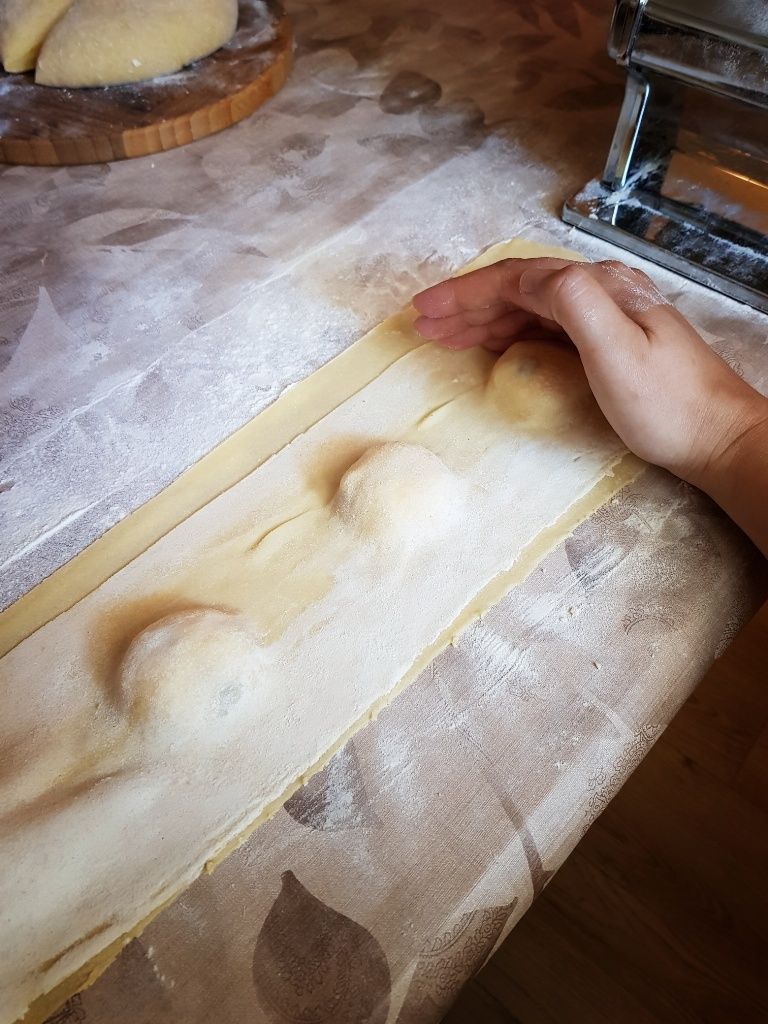December 17, 2018 — Back when the basic ingredients of this recipe were scarce and costly, the famous Labinski krafi were traditionally prepared only for the most festive occasions like weddings and christenings. Today, this delectable pasta filled with an aromatic cheese mixture is an essential part of the common Istrian Christmas feast menu.
Labinski krafi are basically sweet ravioli but what is special about this particular variety is that in Labin, krafi are served two ways: either with a savory ragù (meat-based sauce commonly served with pasta) or as a dessert.
This recipe might seem a little daunting but if you have a pasta maker that you've used at least once, you are only a few steps away from successfully making one of the most delicious Istrian specialties.
Pasta dough
300g flour (type 00)
pinch of salt
1 whole egg
2 egg yolks
water, as needed
Filling
300g young cheese, grated
200g matured cheese, grated
150g granulated sugar
1/2 cup rum-soaked raisins
1 whole lemon zest
1 whole egg
2 egg whites
1 tsp vanilla essence
pinch of salt
breadcrumbs, if needed
1) To make the pasta dough, use a fork or tips of your fingers to incorporate the ingredients together until everything is well combined. Start kneading and work the dough until you activate the gluten in the flour and the dough becomes elastic.
Though kneading is no easy work, there's really no secret to it. Basically, you are done when you develop upper body of a heavyweight boxer or when you notice you have a smooth, lump-free ball of dough; whichever comes first.
Use plastic wrap to cover the dough and put it in the fridge to rest for at least 30 minutes before you use it. Meanwhile, you can make the filling.
Tip: As a rule of thumb, for a classic egg pasta dough, most recipes will instruct you to use 1 whole egg per every 100 grams of flour. However, in this recipe, don't be tempted to use 3 whole eggs because extra egg whites will make the dough too chewy and springy, whereas using only yolks gives it a nice soft texture.
2) To make the filling, combine all the ingredients in a large bowl and mix well using a fork. If the mixture seems a bit runny, add some breadcrumbs.
As for the cheese, you can use either cow or sheep cheese, or a combination of both. I prefer to use 300 grams of young, hard sheep cheese, grated more coarsely, and 200 grams of aged, parmesan-like cow cheese, finely grated.
3) Here comes the fun part! Dust your worktop with flour so that the pasta sheets don't stick to it. Clamp the pasta maker to the side of your worktop, and start feeding the dough through the rollers.
Start with the thickest setting, and gradually adjust the rollers until you get a thin pasta sheet suitable for ravioli. Repeat until you've used all the dough. You can make as many sheets you like, but making them in pairs is more convenient.

4) To make the krafi, place an equal amount of filling every 5cm (see photo above), cover it with the second pasta sheet, and lightly press around each portion of the filling to force the air out (see photo below). This step can be skipped, but if you leave the air locked inside, it will make your krafi look all wrinkly once they're cooked. Finally, use a classic ravioli stamp-cutter (or a glass) to cut out the krafi.
5) Bring a pot of salted water to a rolling boil, and cook them. This shouldn't take longer than 2-3 minutes; krafi are finished cooking when they float to the surface.
Traditionally, if enjoyed as a dessert, Labinski krafi are served either simply sprinkled with some more grated cheese or coated in buttered breadcrumbs, but since you've already done all this work, why not take it up a notch and make a delicious caramel-based sauce with coarsely ground toasted walnuts? Dobar tek!

Stay tuned for more delicious recipes by following TCN's gourmet page.


